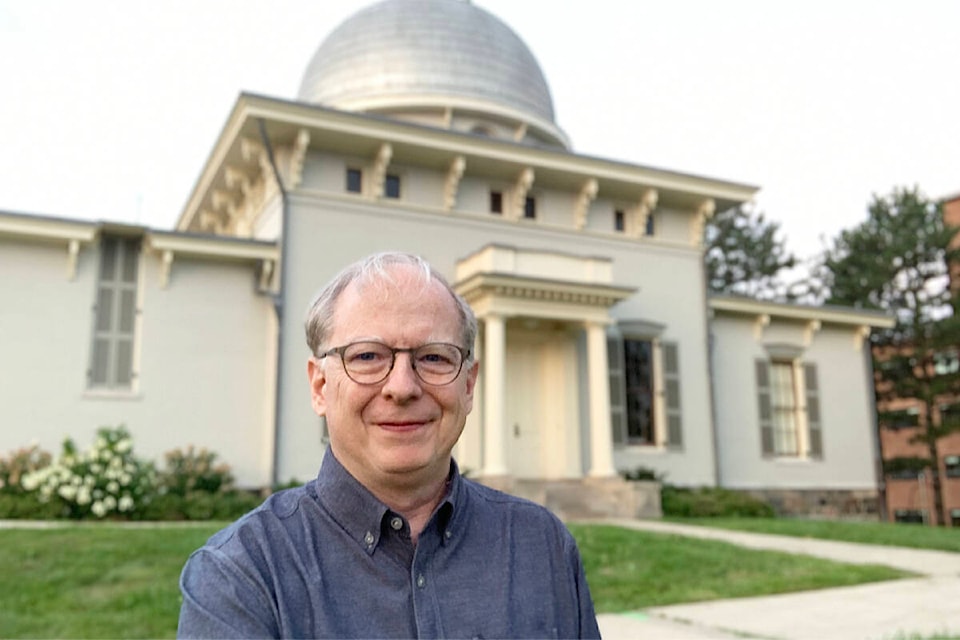The Nanaimo Astronomy Society’s next guest speaker is advising everyone to get out and enjoy clear, dark night skies while they still can.
Patrick Seitzer, research professor emeritus with the University of Michigan’s department of astronomy, estimates that over the next 10 years, more than 400,000 new satellites are planned to be launched into low Earth orbit, adding to the 50,000 low Earth orbit objects that are currently tracked and catalogued. He warns that most, maybe even all, of those objects could be visible to the unaided eye, even in light-polluted skies.
Seitzer specializes in making optical observations of space debris and has worked on the problem of having large numbers of bright satellites and their visual effect on the night sky.
“Since I was very young I was always interested in the stars and I wanted to study them and learn more about them and space travel … through great luck and hard work I was able to make a career our of it,” he said. “I’ve been exceptionally lucky to follow my dream since I was a kid.”
During his working career, he specialized in studying star clusters – how they’re formed, how the stars move between them, internal dynamics and galactic tidal field limitiations.
“In the late ’90s, I was working with a wide field telescope in Chile that the University of Michigan owns … and I began to notice more and more satellite trails in the images that I took,” Seitzer said. “That led me into space debris – what happens when satellites break up, when they fragment, what’s the population, and I was very lucky to be able to turn that into a NASA project, which was funded for 16 years, to study the population of space debris at geosynchronous orbit.”
When that project ended and Seitzer retired, the problem of bright satellites in the night sky became apparent when SpaceX launched its first StarLink satellites in 2019. He began working with the American Astronomical Society and others on that problem.
“What can be done to make them fainter? How do you handle it in astronomy? … Is it a real challenge to astronomers? The answer is yes,” he said. “We set goals to try to make them as faint or fainter, so you wouldn’t see them with the unaided eye and I think that’s going to be a tough goal to meet, but companies like SpaceX are certainly trying very hard to achieve that.”
Private companies such as SpaceX, Amazon, OneWeb, Samsung, Guo Wang and others have plans or are already launching tens of thousands of low Earth orbit satellites in what are called mega-constellations over the next few years, mostly to provide communication services.
According to a report from the U.S. Government Accountability Office last fall, so much orbiting hardware and debris could mean damage or destruction of satellites that could affect commercial services, scientific observations and even national security. Emissions into the upper atmosphere from rocket launches, along with particle emissions from vehicle and satellite re-entries could affect atmospheric temperatures and the ozone layer. The report also noted that large numbers of satellites don’t just reflect sunlight, they also transmit radio emissions that can interfere with astronomical natural phenomena observations.
“We’ll see how many of those [satellite constellation projects] come to fruition, but even if a small percentage of those come to fruition, say 50,000, it’s still a huge problem for astronomy,” Seitzer said.
He said more satellites are becoming visible all the time and the view of the night sky is changing rapidly, so he encourages people to seek out a dark sky site on a moonless night and just look at the night sky.
“It’s one of the most amazing shows that nature has to offer,” he said. “But there are these intruders, these new satellites that are coming in and many of which are very, very bright.”
Seitzer will be the guest speaker at the Nanaimo Astronomy Society’s first meeting of 2023 on Thursday, Jan. 26, at 7 p.m. at the Beban Park social centre. The meeting will also be held on Zoom for society members. For more information, visit www.nanaimoastronomy.com.
READ ALSO: Solar system ambassador will talk about asteroid crash test at Nanaimo astronomy meeting
chris.bush@nanaimobulletin.com
Like us on Facebook and follow us on Twitter
